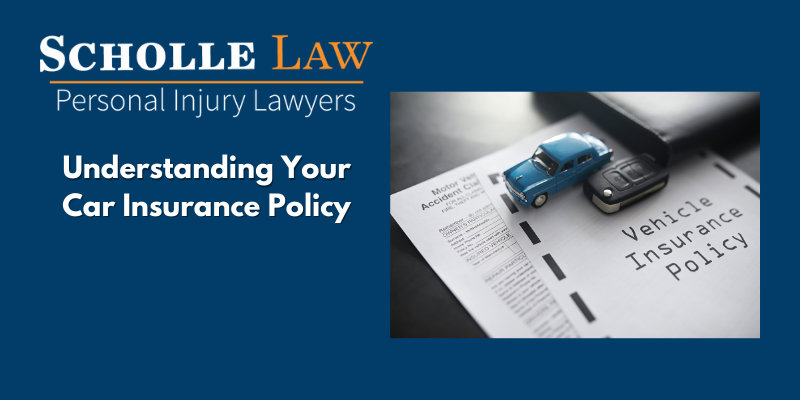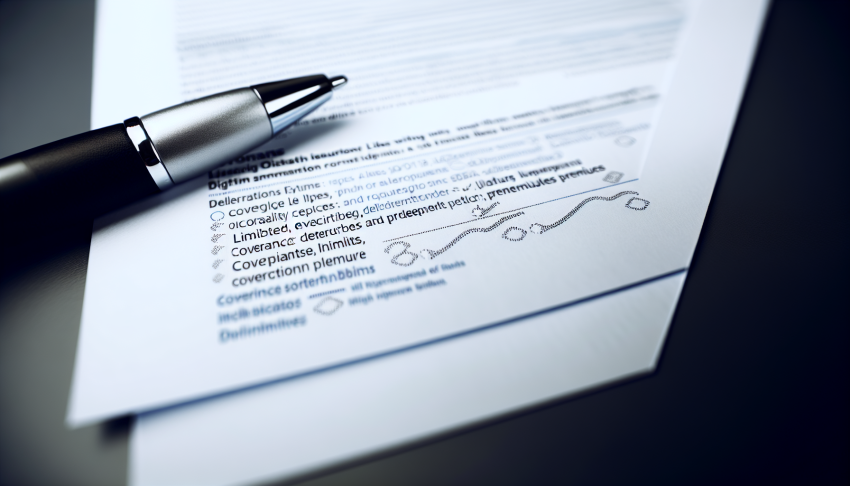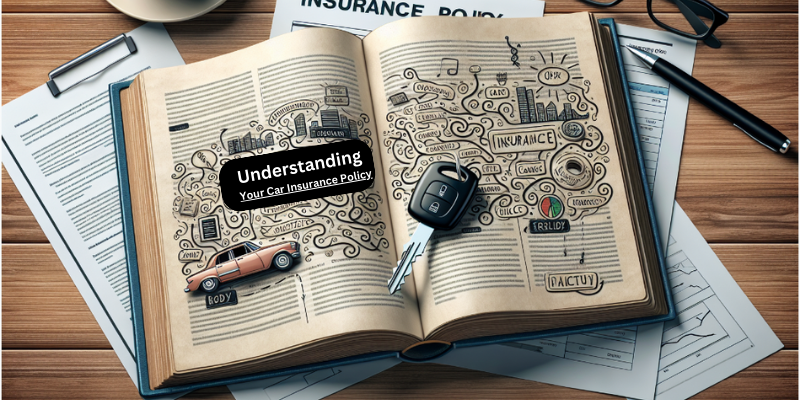4.9 Rating
Google REVIEWS
Leaders in Georgia Personal Injury Law Since 1995
Understanding Your Car Insurance Policy
What does my car insurance policy actually cover? That’s the question many drivers ask, but the answer often gets lost in a sea of insurance lingo. Our guide to understanding your car insurance policy cuts through the confusion to deliver a no-nonsense breakdown of your policy. Expect to understand key insurance concepts, from types of coverage to what your deductible means, empowering you to take control of your policy choices.

Key Takeaways
- Understanding your auto insurance policy, including the types of coverage (liability, collision, comprehensive, etc.), deductibles, limits, and both mandatory and optional components, is critical to ensure appropriate financial protection in the event of an accident.
- Reviewing and adjusting your insurance policy periodically is important to reflect changes in your situation, such as new drivers or change in assets, and ensuring adequate coverage by considering factors like the value of your car, usage, and your financial status.
- Savings on car insurance premiums can be achieved through multiple strategies, including comparing rates, raising deductibles, bundling policies, maintaining a good driving record, and taking advantage of various discounts offered by insurance providers.

Decoding Your Auto Insurance Policy
Your auto insurance policy is essentially a contract between you and your insurance company. It lays out the terms and conditions that both parties must follow. You agree to pay a premium, and in return, the insurance company pays for coverage for specific types of losses, as defined in the policy. This agreement may seem simple, but the devil is in the details. It’s crucial to understand what your policy covers and what it doesn’t to be prepared when an accident happens.
A standard auto insurance policy provides various types of coverage, including property coverage for damage or theft of your car, liability coverage for legal responsibility to others for bodily injury or property damage, and medical coverage for the cost of treating injuries, rehabilitation, and sometimes lost wages and funeral expenses. But that’s not all. Within each core coverage type, there are specific coverage types, each with its own nuances. For instance, Collision coverage covers damage to your car from accidents, while Comprehensive coverage extends to non-collision events like theft or fire.
Now, let’s talk about deductibles. These are amounts you agree to pay out-of-pocket towards a covered claim before your insurance coverage pays the remainder. For instance, if you have a $500 deductible and $5,000 in damages, you’ll pay $500 and your insurance company will cover the remaining $4,500. But remember, raising your deductible can decrease your insurance premiums. It’s a balancing act between paying lower premiums now and potentially higher out-of-pocket costs later.
Coverage Types
Now that we’ve defined the broad types of coverage, let’s delve deeper into each one. The core coverage types include:
- Liability
- Collision
- Comprehensive
- Uninsured/underinsured motorist
- Medical payments
- Personal injury protection
Liability coverage, including auto liability coverage and liability insurance, is often mandated by most states and consists of bodily injury liability, covering injuries you cause to others if at fault in an accident, and property damage liability, paying for damage to another person’s property while driving. In a nutshell, liability coverage protects you from the financial fallout of being responsible for an accident.
On the other hand, comprehensive and collision coverage addresses the repair or replacement of your vehicle after traffic accidents, collisions with other objects, or rollover events.
Not all damage to your vehicle comes from traffic accidents, though. Comprehensive coverage helps in repairing or replacing your vehicle in case of non-collision events, such as:
- theft
- fire
- hail
- vandalism
- animal collisions
Uninsured/Underinsured Motorist Coverage provides financial protection for medical bills and car damage when involved in an accident with a driver who has insufficient or no insurance.
Lastly, medical payments coverage and personal injury protection cover costs associated with injuries to you or your passengers, including medical expenses, and may extend to cover additional expenses such as childcare or lost income resulting from the injuries.
Limits and Deductibles
While understanding the types of coverages is important, it’s equally crucial to grasp the concepts of limits and deductibles, as these determine your out-of-pocket costs and the maximum payout of your insurance company in a claim. Limits specify the maximum amount an insurance policy will pay out per accident or claim, with these limits detailed on the policy’s declarations page.
Deductibles are the amounts you agree to pay out of pocket when filing a claim, applied to coverages such as comprehensive, collision, and uninsured/underinsured motorists property damage. Think of it as your financial participation in the claim. For instance, if you have a $500 deductible and $5,000 in damages, you’ll pay the first $500, and your insurer covers the remaining $4,500. If you raise your deductible to $1,000, you’ll pay the first $1,000, and your insurer will pay $4,000 in this scenario.
While raising the deductible can decrease insurance premiums, it’s crucial to have funds set aside for these higher out-of-pocket expenses in the event of a claim. It’s also important to note that if the costs of an accident exceed your policy’s coverage limits, you are financially responsible for the amount over the limits. Thus, choosing coverage limits and deductibles is a delicate balancing act between risk and affordability.
Exclusions and Endorsements
Insurance is all about covering risks, but not all risks are covered. That’s where exclusions come in. An exclusion is something a car insurance policy will not cover, which defines the limits of coverage or eliminates coverage based on the cause of a loss. For instance, if a family member with a poor driving record is excluded from your policy, any accidents they cause won’t be covered.
On the flip side, endorsements modify the standard coverage of an insurance policy and can add, modify, reduce, or remove coverage terms. Think of them as customizations to tailor your policy to your unique needs. For instance, endorsements can include rental reimbursement insurance after a covered accident or insurance for custom equipment and extra installations like navigation systems.
Navigating exclusions and endorsements might feel like walking through a minefield, but understanding them helps ensure you’re not caught off guard when filing a claim. Knowing what’s not covered is just as important as knowing what is. Likewise, endorsements empower you to personalize your coverage, so it fits like a glove.

Navigating the Declarations Page
Imagine having a single page that summarizes your entire auto insurance policy. That’s what the declarations page does. It’s a snapshot of your policy, including details such as the year, make, model, VIN of the insured vehicles, policy period, and the names of all drivers on the policy.
But that’s just the beginning. The declarations page also provides:
- A breakdown of coverage types
- Liability limits
- Deductibles
- Lists the premium paid for each vehicle
In essence, it’s your policy at a glance, a handy reference for when you need to know your coverage details or when filing a claim.
Reviewing your declarations page regularly ensures accuracy and reflects any basic details that have changed at each policy renewal or modification. So, the next time you receive your policy renewal, don’t just toss it aside. Take a few minutes to review the declarations page and ensure everything is as it should be.

Making Sense of Insurance Terminology
Car insurance policies are filled with terms that might seem like a foreign language. But understanding these terms is crucial to ensure proper coverage and avoid misunderstandings. Being familiar with your policy helps you understand what is covered, which can facilitate a smoother claims process.
When reading your policy, pay close attention to key terms as certain words like ‘except,’ ‘all,’ and ‘however’ can significantly alter coverage explanations. If there are words in your policy that you do not understand, checking the definitions page or contacting your insurer is important for clarification.
Remember, knowledge is power. Knowing how to read an auto insurance policy helps you understand the coverage you have purchased and reduces uncertainties. If you come across something in your policy that you do not understand, it’s advisable to call your agent, broker, or insurance company for assistance.
To better understand complex insurance verbiage, speaking with an insurance agent or a financial advisor can be highly beneficial.
Evaluating Your Coverage Needs
When it comes to auto insurance, one size definitely does not fit all. Evaluating your coverage needs is an essential step in ensuring you’re adequately protected. It’s a common misconception that meeting the state-required minimum coverage is enough. In reality, these minimums often fall short of covering the costs associated with significant accidents. In fact, it’s recommended to have liability coverage of at least $100,000 per person, $300,000 per accident, and $100,000 for property damage to ensure adequate financial protection.
Your coverage needs also depend on how you use your vehicle. Whether you’re using it for commuting, pleasure, or business can impact your insurance coverage needs. Similarly, the age and value of your car, your budget, and the potential savings from self-insurance options like dropping collision and comprehensive coverage for older vehicles should also be considered when choosing coverages.
In addition, your assets and financial situation play a role in determining your coverage needs. Assessing your assets and the protection offered by your current insurance policies can help identify if additional coverage is needed. For instance, if you owe more on your car loan than the car’s market value, GAP insurance can be beneficial to cover the difference.
Tips for Adjusting Your Policy
Your auto insurance policy isn’t set in stone. In fact, it should be a reflection of your current situation. As such, it’s important to review your coverage options periodically to ensure that your personal assets are adequately protected as they change over time.
Changes in household members, such as the addition of a new driver, or someone moving out, should prompt you to update the car insurance policy to add or remove drivers. This helps maintain appropriate coverage and ensures that your policy accurately reflects your current situation.
If during your review, you find gaps in coverage or discover that you are underinsured, it’s time to shop for new coverage to fill those gaps. Remember, your auto insurance policy is more than just a legal requirement—it’s your financial safety net. So, make sure it’s up to the task.
How to File a Claim
While you can certainly file a car accident claim on your own, you should seriously consider working with an experienced car accident law firm like Scholle Law. The insurance companies make it a habit of trying to pay out the least amount possible. At Scholle Law, we’ve been taking them on for over 27 years.
Working with Scholle Law considerably increases your chances of getting a higher compensation than if you decide to file on your own. In fact, national statistics show that individuals who work with an experienced legal team often receive settlements that are significantly larger than those who go it alone. The experience and negotiation skills of a trained attorney can lead to a more favorable outcome, navigating the complexities of the legal system and insurance company tactics with ease. By partnering with Scholle Law, you’re not just hiring a lawyer; you’re gaining an advocate who is dedicated to fighting for your rights and ensuring that you receive the justice and compensation you deserve.
Dealing With The Insurance Company
Filing a claim can be a stressful process, especially if you’re dealing with it for the first time. Your attorney at Scholle Law can take care of all of this.
Cooperation is key when filing a claim. Here are some steps to follow:
- Be prepared to provide necessary documentation.
- Protect your damaged property from further damage.
- An insurance adjuster will determine if the vehicle can be repaired or is a total loss.
- The adjuster may conduct on-site investigations or require vehicle inspection at a certified repair shop.
Remember, the claims process is a two-way street. You have the right to review and question the insurance settlement offer, research appropriate compensation, and negotiate with assistance from your agent if needed. After a final settlement, ensure all financial obligations are covered by signing a release, marking the end of the claims process.
And remember, if you need guidance throughout the process, don’t hesitate to consult with your insurance agent.
Saving Money on Car Insurance
Who doesn’t love a good deal? When it comes to car insurance, there are several strategies you can use to secure lower premiums. One of the most effective ways is to compare rates from various car insurance companies.
Here are some strategies to help you secure the right coverage at the lowest price:
- Compare rates from multiple insurance providers
- Consider raising your deductible
- Bundle your car insurance with other policies
- Maintain a good driving record
- Take advantage of discounts offered by insurance providers
By implementing these strategies, you can save money on your car insurance premiums.
Discounts are another great way to save on auto insurance premiums. Here are some discounts you can leverage for significant savings:
- Multi-car discount
- Early shopper discount
- Loyalty discount
- Bundling policies discount
Keeping a clean driving record and maintaining good credit can also play a role in obtaining lower car insurance rates.
Remember, saving money on car insurance isn’t just about finding the lowest premium. It’s about finding the best value – the right balance between cost and coverage. And with the right knowledge and a bit of time spent comparison shopping, you can find a policy that offers great coverage at a price that fits your budget.
Summary
Navigating the world of auto insurance can seem daunting, but with a bit of knowledge and understanding, and the help of an experienced auto accident attorney, it’s entirely manageable. From decoding your auto insurance policy and understanding the nuances of coverage types, limits, deductibles, exclusions, and endorsements, to navigating the declarations page and making sense of insurance terminology, we’ve covered it all. We’ve also explored how to evaluate your coverage needs, adjust your policy as needed, file a claim, and save money on car insurance.
Remember, your car insurance policy is more than just a legal requirement. It’s your financial safety net, protecting you and your assets from the unforeseen perils of the road. So, take the time to understand it, review it regularly, and ensure it reflects your current situation and coverage needs. Armed with the knowledge from this guide, you’ll be in the driver’s seat, making informed decisions and getting the most from your car insurance policy.
Frequently Asked Questions
How do you read insurance limits?
To read insurance limits, look for a sequence of three numbers separated by slashes, such as 100/300/50, which represents the per person bodily injury limit, total bodily injury limit per accident, and property damage limit per accident.
What are the 3 parts of an auto insurance policy?
Most auto insurance policies consist of three major parts: liability insurance for bodily injury, liability insurance for property damage, and uninsured/underinsured motorists coverage. Optional coverages may also include underinsured motorist, medical expense, collision, and comprehensive coverage.
How do you read and understand an insurance policy?
To read and understand an insurance policy, start with determining who qualifies as an insured, confirm all forms and endorsements, and then read the insurance agreement and exclusions carefully. Pay close attention to exceptions to the exclusions and refer to other sections as necessary. Remember to read the overview on your declarations page, familiarize yourself with insurance terminology, and carefully review the coverage and exclusions to fully understand your insurance policy.
What are the core coverage types in a car insurance policy?
The core coverage types in a car insurance policy include liability, collision, comprehensive, uninsured/underinsured motorist, medical payments, and personal injury protection.
Liability coverage is essential as it covers the costs if you are at fault in an accident that causes injury to others or damage to their property.
Collision coverage helps pay for repairs to your car if it’s damaged in a collision with another vehicle or object. Comprehensive coverage, on the other hand, provides protection against risks such as theft, vandalism, or natural disasters that are not collision-related.
Uninsured/underinsured motorist coverage is crucial for when you’re involved in an accident with a driver who either has no insurance or has insufficient coverage.
Medical payments coverage assists with medical expenses resulting from an accident, regardless of who is at fault.
What is a deductible in car insurance?
A deductible in car insurance is the amount you agree to pay out of pocket when filing a claim before your insurance coverage kicks in to pay the remaining costs.
